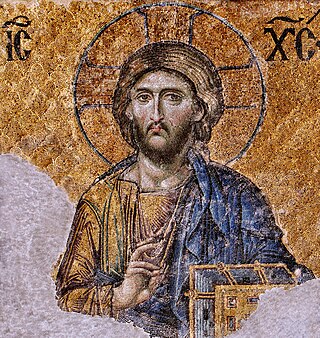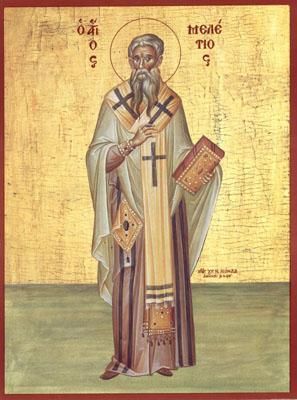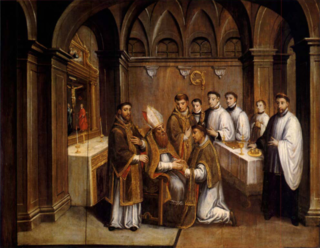
The First Council of Nicaea was a council of Christian bishops convened in the Bithynian city of Nicaea by the Roman Emperor Constantine I in AD 325.

Pope Siricius was the bishop of Rome from December 384 to his death. In response to inquiries from Bishop Himerius of Tarragona, Siricius issued the Directa decretal, containing decrees of baptism, church discipline and other matters. His are the oldest completely preserved papal decretals. He is sometimes said to have been the first bishop of Rome to call himself pope.

Theodoret of Cyrus or Cyrrhus was an influential theologian of the School of Antioch, biblical commentator, and Christian bishop of Cyrrhus (423–457). He played a pivotal role in several 5th-century Byzantine Church controversies that led to various ecumenical acts and schisms. He wrote against Cyril of Alexandria's 12 Anathemas which were sent to Nestorius and did not personally condemn Nestorius until the Council of Chalcedon. His writings against Cyril were included in the Three Chapters Controversy and were condemned at the Second Council of Constantinople. Some Chalcedonian and East Syriac Christians regard him as a "full" saint.

Flavian, sometimes Flavian I, was Archbishop of Constantinople from 446 to 449. He is venerated as a saint by the Eastern Orthodox Church and the Catholic Church.
St. Flavian I of Antioch was a bishop or Patriarch of Antioch from 381 until his death.

Saint Meletius was a Christian bishop of Antioch from 360 until his death in 381. He was opposed by a rival bishop named Paulinus and his episcopate was dominated by the schism, usually called the Meletian schism. As a result, he was exiled from Antioch in 361–362, 365–366 and 371–378. One of his last acts was to preside over the First Council of Constantinople in 381.
Alexander of Constantinople was a bishop of Byzantium and the first Archbishop of Constantinople. Scholars consider most of the available information on Alexander to be legendary.
Evagrius was the archbishop of Constantinople for a brief period in 370, and possibly in 380.
Nectarius was the archbishop of Constantinople from AD 381 until his death, the successor to Saint Gregory Nazianzus and predecessor to St. John Chrysostom.
Evagrius Scholasticus was a Syrian scholar and intellectual living in the 6th century AD, and an aide to the patriarch Gregory of Antioch. His surviving work, Ecclesiastical History, comprises a six-volume collection concerning the Church's history from the First Council of Ephesus (431) to the emperor Maurice’s reign until Scholasticus' death.
Domnus II was the Patriarch of Antioch between 442 and 449 and a friend of the influential Bishop of Cyrrhus, Saint Theodoret.

Theodore of Mopsuestia was a Christian theologian, and Bishop of Mopsuestia from 392 to 428 AD. He is also known as Theodore of Antioch, from the place of his birth and presbyterate. He is the best known representative of the middle Antioch School of hermeneutics.

Eustathius of Antioch, sometimes surnamed the Great, was a Christian bishop and archbishop of Antioch in the 4th century. His feast day in the Eastern Orthodox Church is February 21.

Eusebius of Vercelli was a bishop from Sardinia and is counted a saint. Along with Athanasius, he affirmed the divinity of Jesus against Arianism.
Acacius of Beroea, a Syrian, lived in a monastery near Antioch, and, for his active defense of the Church against Arianism, was made Bishop of Berroea in 378 AD, by Eusebius of Samosata.

Lucifer of Cagliari was a bishop of Cagliari in Sardinia known for his passionate opposition to Arianism. He is venerated as a Saint in Sardinia, though his status remains controversial.
The Second Council of Ephesus was a Christological church synod in 449 AD convened by Emperor Theodosius II under the presidency of Pope Dioscorus I of Alexandria. It was intended to be an ecumenical council, and it is accepted as such by the miaphysite churches but was rejected by the Chalcedonian dyophysites. It was explicitly repudiated by the next council, the Council of Chalcedon of 451, recognised as the fourth ecumenical council by Chalcedonian Christians, and it was named the Latrocinium or "Robber Council" by Pope Leo I; the Chalcedonian churches, particularly the Roman Catholic and Eastern Orthodox communions, continue to accept this designation, while the Oriental Orthodox repudiate it.

The Church History of Eusebius, the bishop of Caesarea was a 4th-century pioneer work giving a chronological account of the development of Early Christianity from the 1st century to the 4th century. It was written in Koine Greek, and survives also in Latin, Syriac and Armenian manuscripts.
Theodotus, patriarch of Antioch, in AD 420 succeeded Alexander, under whom the long-standing schism at Antioch had been healed, and followed his lead in replacing the honoured name of Chrysostom on the diptychs of the church. He is described by Theodoret, at one time one of his presbyters, as "the pearl of temperance," "adorned with a splendid life and a knowledge of the divine dogmas". Joannes Moschus relates anecdotes illustrative of his meekness when treated rudely by his clergy, and his kindness on a journey in insisting on one of his presbyters exchanging his horse for the patriarch's litter. By his gentleness he brought back the Apollinarians to the church without rigidly insisting on their formal renouncement of their errors. On the real character of Pelagius's teaching becoming known in the East and the consequent withdrawal of the testimony previously given by the synods of Jerusalem and Caesarea to his orthodoxy, Theodotus presided at the final synod held at Antioch at which Pelagius was condemned and expelled from Jerusalem and the other holy sites, and he joined with Praylius of Jerusalem in the synodical letters to Rome, stating what had been done. The most probable date of this synod is that given by Hefele: A.D. 424. When in 424 Alexander, founder of the order of the Acoemetae, visited Antioch, Theodotus refused to receive him as being suspected of heretical views. His feeling was not shared by the Antiochenes, who, ever eager after novelty, deserted their own churches and crowded to listen to Alexander's fervid eloquence. Theodotus took part in the ordination of Sisinnius as patriarch of Constantinople, in February 426, and united in the synodical letter addressed by the bishops then assembled to the bishops of Pamphylia against the Massalian heresy. He died in 429.

Paulinus II was a claimant to the See of Antioch from 362 to 388. He was supported by members of the Eustathian party, and was a rival to Meletius of Antioch. The Eustathians objected to Meletius having been consecrated by Arians, and had begun to meet separately. Lucifer of Calaris ordained Paulinus as bishop, thus effecting a schism in the church.
 " De Viris Illustribus - Evagrius the bishop ".
" De Viris Illustribus - Evagrius the bishop ".








